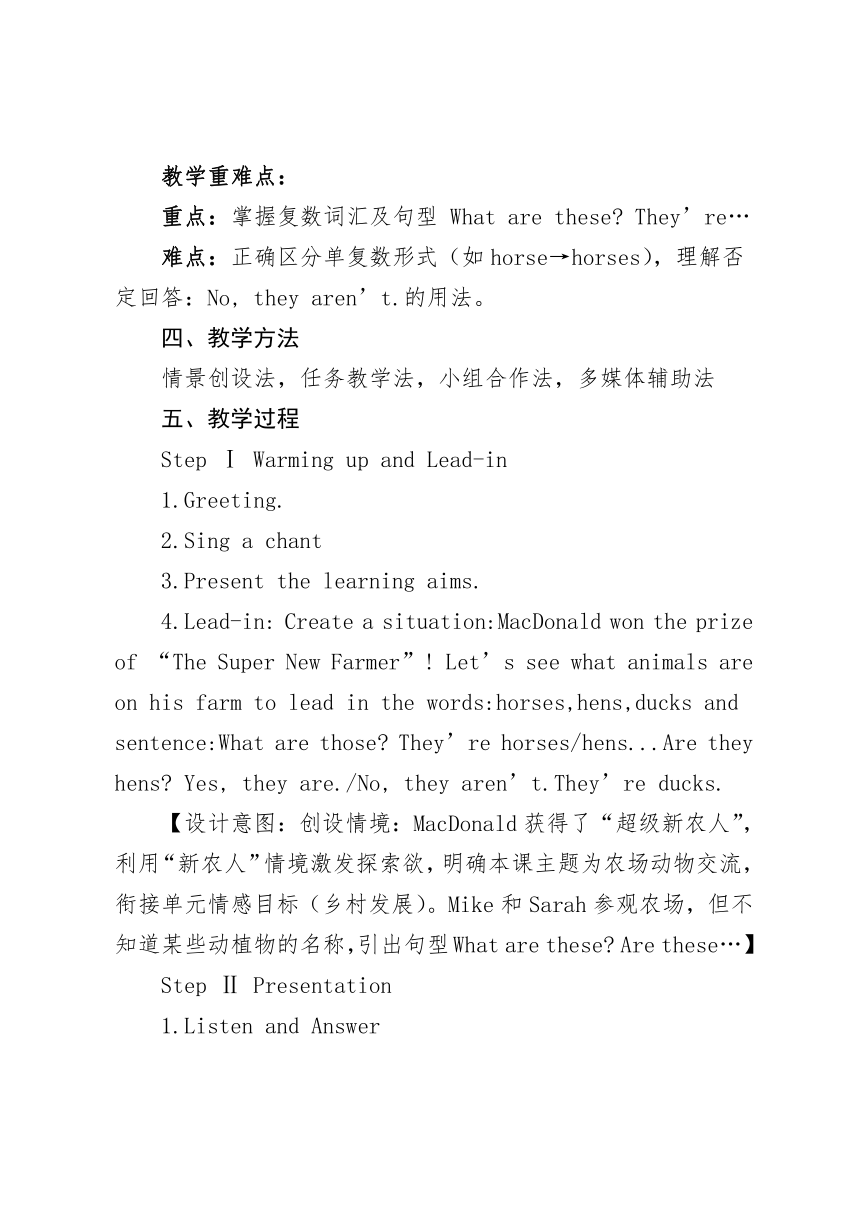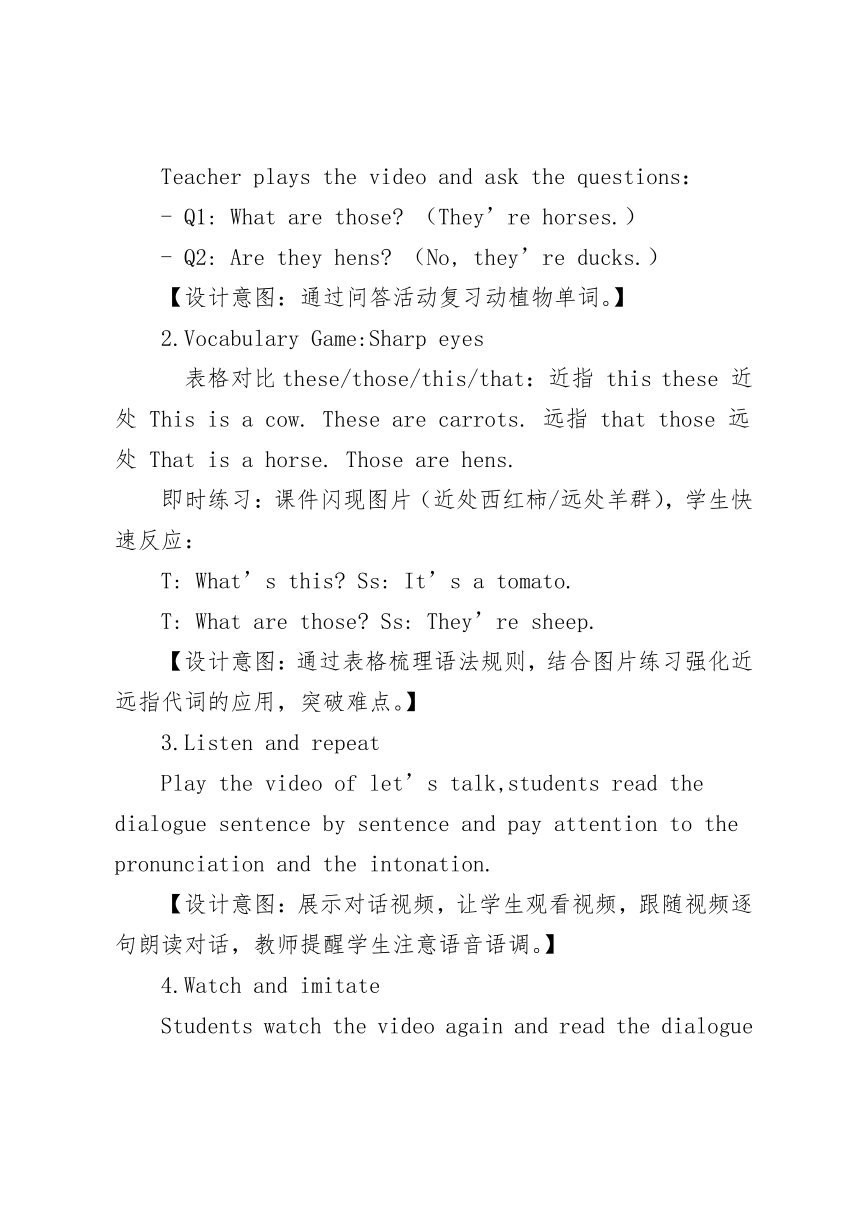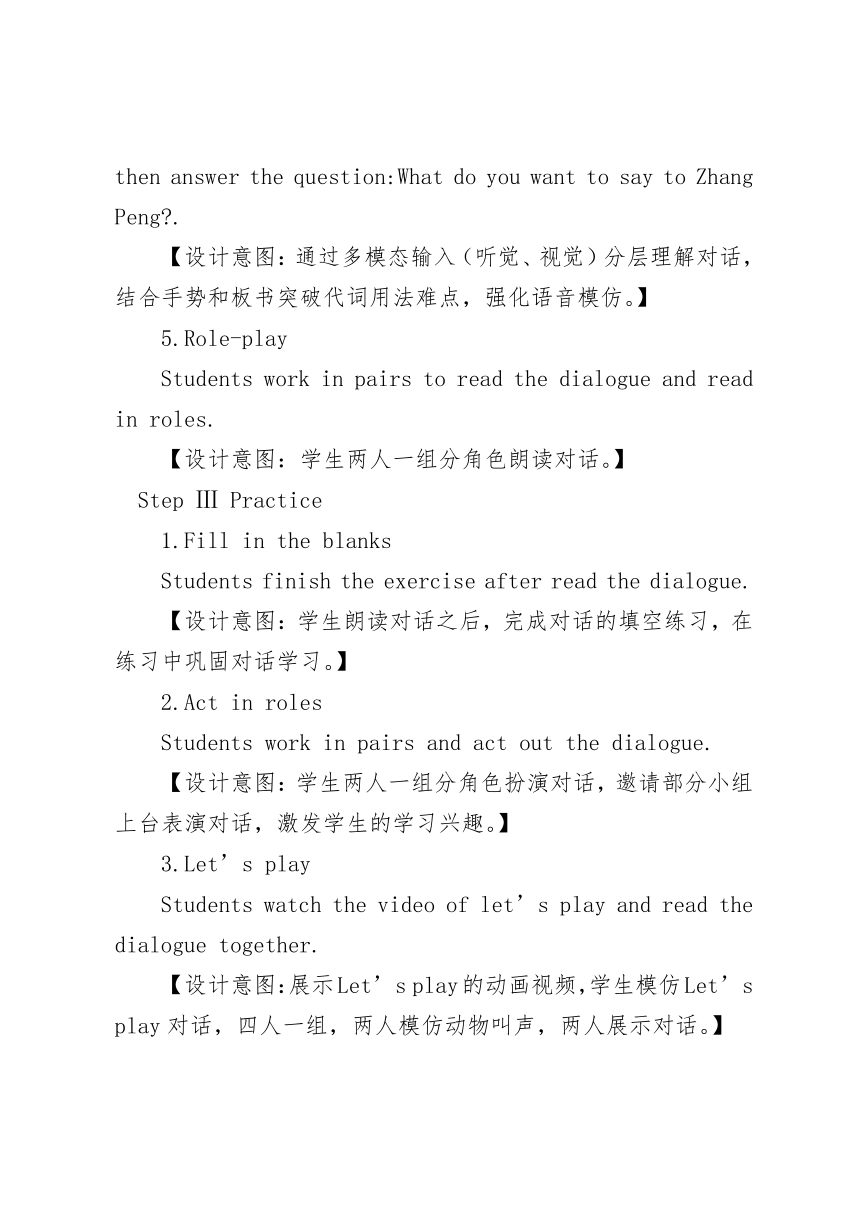Unit 4 At the farm Part B Let'stalk 表格式教学设计
文档属性
| 名称 | Unit 4 At the farm Part B Let'stalk 表格式教学设计 |  | |
| 格式 | docx | ||
| 文件大小 | 639.1KB | ||
| 资源类型 | 教案 | ||
| 版本资源 | 人教版(PEP) | ||
| 科目 | 英语 | ||
| 更新时间 | 2025-06-02 19:57:07 | ||
图片预览





文档简介
《Unit4 At the farm B Let’s talk》教学设计
一、单元及课时学习内容分析
人教版三年级起点四年级英语下册第四单元At the farm,围绕“人与自然”的主题范畴,主题是认识农场动物和农作物,学习询问和描述农场物品的句型,如:What are these They’re… / Are these… Yes, they are. No, they aren’t.培养学生观察自然、热爱劳动的意识。本单元以“Explore the farm”为话题,逐步学习农场动植物的名称及其特征。本次授课的是 Unit4 At the farm Part B Let’s talk。本课时围绕“Farm visit”展开,通过Mike和Sarah参观农场的对话,呈现核心词汇 horses, hens,ducks 及句型 What are those They’re… / Are these… 引导学生学会用英语描述农场事物并激发对自然的好奇心。
学情分析
四年级学生已有一定的英语基础,能够进行简单的问答和对话。他们对动物和自然充满兴趣,且具备较强的模仿能力和合作意识。本节课为Part B Let's talk,聚焦农场动物的认知与交流。教材通过Mike和Sarah参观MacDonald农场的对话,呈现核心句型“What are those They’re...”“Are they... Yes, they are./No, they aren’t.”,并渗透horse, cow, hen等动物词汇的复数形式(注意sheep单复数同形)。此外,对话中“How many horses do you have Seventeen.”进一步强化数量提问的用法,同时通过农场情景和互动活动,帮助学生巩固复数表达,提升语言应用能力。通过“超级新农人”情境,感知现代农村的发展机遇,树立“乡村自有广阔天地”的积极认知。
三、教学目标
1.学习理解:
a.能认读并理解词汇:horse, cow, hen,duck的意思,并掌握horse/hen的复数形式(horses/hens)及发音。
b.能在情境中运用句型 What are those They’re… / Are these… Yes, they are. /No, they aren’t.询问和回答农场物品。
2.应用实践:
a.通过角色扮演和游戏,学生能流利朗读对话并用正确语音语调进行问答。
b.在小组活动中,学生能合作完成农场调查任务,巩固核心语言。
3.迁移创新:
a.能准确模仿对话语音语调,分角色表演对话,做到发音清晰、节奏自然。
b.能观察并描述生活中的植物或动物,培养热爱自然、珍惜劳动成果的意识。
根据以上目标和学生实际我确立了以下重、难点:
教学重难点:
重点:掌握复数词汇及句型 What are these They’re…
难点:正确区分单复数形式(如horse→horses),理解否定回答:No, they aren’t.的用法。
四、教学方法
情景创设法,任务教学法,小组合作法,多媒体辅助法
五、教学过程
Step Ⅰ Warming up and Lead-in
1.Greeting.
2.Sing a chant
3.Present the learning aims.
4.Lead-in: Create a situation:MacDonald won the prize of “The Super New Farmer”! Let’s see what animals are on his farm to lead in the words:horses,hens,ducks and sentence:What are those They’re horses/hens...Are they hens Yes, they are./No, they aren’t.They’re ducks.
【设计意图:创设情境:MacDonald获得了“超级新农人”,利用“新农人”情境激发探索欲,明确本课主题为农场动物交流,衔接单元情感目标(乡村发展)。Mike和Sarah参观农场,但不知道某些动植物的名称,引出句型What are these Are these…】
Step Ⅱ Presentation
1.Listen and Answer
Teacher plays the video and ask the questions:
- Q1: What are those (They’re horses.)
- Q2: Are they hens (No, they’re ducks.)
【设计意图:通过问答活动复习动植物单词。】
2.Vocabulary Game:Sharp eyes
表格对比these/those/this/that:近指 this these 近处 This is a cow. These are carrots. 远指 that those 远处 That is a horse. Those are hens.
即时练习:课件闪现图片(近处西红柿/远处羊群),学生快速反应:
T: What’s this Ss: It’s a tomato.
T: What are those Ss: They’re sheep.
【设计意图:通过表格梳理语法规则,结合图片练习强化近远指代词的应用,突破难点。】
3.Listen and repeat
Play the video of let’s talk,students read the dialogue sentence by sentence and pay attention to the pronunciation and the intonation.
【设计意图:展示对话视频,让学生观看视频,跟随视频逐句朗读对话,教师提醒学生注意语音语调。】
4.Watch and imitate
Students watch the video again and read the dialogue then answer the question:What do you want to say to Zhang Peng .
【设计意图:通过多模态输入(听觉、视觉)分层理解对话,结合手势和板书突破代词用法难点,强化语音模仿。】
5.Role-play
Students work in pairs to read the dialogue and read in roles.
【设计意图:学生两人一组分角色朗读对话。】
Step Ⅲ Practice
1.Fill in the blanks
Students finish the exercise after read the dialogue.
【设计意图:学生朗读对话之后,完成对话的填空练习,在练习中巩固对话学习。】
2.Act in roles
Students work in pairs and act out the dialogue.
【设计意图:学生两人一组分角色扮演对话,邀请部分小组上台表演对话,激发学生的学习兴趣。】
3.Let’s play
Students watch the video of let’s play and read the dialogue together.
【设计意图:展示Let’s play的动画视频,学生模仿Let’s play对话,四人一组,两人模仿动物叫声,两人展示对话。】
4.Pair Work
Two students work in pairs to create a dialogue based on pictures (different scenes of the farm) using core sentence patterns.
A: Welcome to my farm! What are those
B: They’re horses. Are they cows
A: No, they aren’t. They’re sheep.
【设计意图:通过结对练习将机械模仿转化为自主输出,关注语言运用的准确性和流畅性。】
Step Ⅳ Consolidation
1.Make a new dialogue.
Students work in groups to finish the worksheet:Make a new dialogue.Students choose the level A or level B to make a new dialogue.
【设计意图:四人小组合作,扮演“星推官”介绍MacDonald农场,完成学习单,创编新对话。使用Word Bank(duck, cow, horse, hen, sheep等)和分层句型,通过真实任务整合语言知识,培养合作能力和创造性思维,同时渗透“乡村推广”的情感目标。】
2.Enjoy a video
Students watch the video together.
【设计意图:学生观看“新农人”视频,感知“新农人”给农村带来的发展变化。】
3.Look and say:
The teacher showed pictures of the "new farmer" at work
T: Mr. MacDonald is a New Farmer. He loves the countryside. Do you think the countryside is important Why
Ss: Yes! There are many animals and vegetables. It’s beautiful!
T: Right! The countryside is the future. We can do a lot there!
【设计意图:结合课件结尾口号“The countryside is the future!”,引导学生关注农村价值,树立积极的劳动观念。】
4.Good to know
Students write down the proverbs about animals.
StepV:Summary
We should love nature,focus on rural values and establish a positive concept of labor.
StepVI Homework:
Need to do:
Listen to the tape and practice the dialogue.
Try to do:
Design your dream farm in different ways.
Try to get some information about smart farm.
Blackboard design
课堂作业设计
实施对象 ___四_年级__一__班 涉及学科 英语
依托课程 国家课程 □地方课程 □校本课程
教材、年级、单元、章节课时 人教PEP四年级下册-第四单元-《At the farm》-第四课时
本课时学习目标 1.通过听,说,读对话的活动,学生能够通过听录音跟读并理解对话内容。 2.在实践练习中,学生能够运用句型What are those They’re… / Are these… Yes, they are. /No, they aren’t.用英语表达提问和回答物品的名称。 3.通过学生感知、体验、实践、参与和合作,培养其日常交际能力及运用英语的综合能力,提高学生合作学习能力,能够观察并描述生活中的植物或动物,培养热爱自然、珍惜劳动成果的意识。
作业目标 预习作业 预习Unit4 Where is my car Part B Let’s learn
课后作业 设计自己的农场,并用英语标明动植物名称。
第一部分 基础型作业(必做)
作业层次 作业内容 作业评价 时长
课 前 预 习 预习Unit4 Where is my car Part B Let’s learn 评价主体: 学生 教师 □家长 □其他——— 评价标准: 学生是否了解41页的horses,hens,ducks三单词的发音和词意以及了解询问和回答物品位置的名称,学生书上是否有预习时所做的笔记。 10分钟
课后巩固 1.朗读并练习Let's talk对话。 2.创编新的有关农场的对话。 评价主体: 学生 教师 家长 □其他——— 评价标准: 1.学生是否流利准确朗读背诵41页所学单词,句型。 2.学生是否积极主动和家人进行互动,用英语介绍自己的农场,介绍是否流利无误。 10分钟
第二部分 探究发展型作业(选做)
作业层次 作业内容 作业评价 时长
课后巩固 设计自己的农场,并用英语标明动植物名称。 评价主体: 学生 教师 家长 其他——— 评价标准: 学生是否按时完成设计自己的农场,并用英语标明动植物名称。制作的农场美观大方。 20分钟
支撑材料 、
一、单元及课时学习内容分析
人教版三年级起点四年级英语下册第四单元At the farm,围绕“人与自然”的主题范畴,主题是认识农场动物和农作物,学习询问和描述农场物品的句型,如:What are these They’re… / Are these… Yes, they are. No, they aren’t.培养学生观察自然、热爱劳动的意识。本单元以“Explore the farm”为话题,逐步学习农场动植物的名称及其特征。本次授课的是 Unit4 At the farm Part B Let’s talk。本课时围绕“Farm visit”展开,通过Mike和Sarah参观农场的对话,呈现核心词汇 horses, hens,ducks 及句型 What are those They’re… / Are these… 引导学生学会用英语描述农场事物并激发对自然的好奇心。
学情分析
四年级学生已有一定的英语基础,能够进行简单的问答和对话。他们对动物和自然充满兴趣,且具备较强的模仿能力和合作意识。本节课为Part B Let's talk,聚焦农场动物的认知与交流。教材通过Mike和Sarah参观MacDonald农场的对话,呈现核心句型“What are those They’re...”“Are they... Yes, they are./No, they aren’t.”,并渗透horse, cow, hen等动物词汇的复数形式(注意sheep单复数同形)。此外,对话中“How many horses do you have Seventeen.”进一步强化数量提问的用法,同时通过农场情景和互动活动,帮助学生巩固复数表达,提升语言应用能力。通过“超级新农人”情境,感知现代农村的发展机遇,树立“乡村自有广阔天地”的积极认知。
三、教学目标
1.学习理解:
a.能认读并理解词汇:horse, cow, hen,duck的意思,并掌握horse/hen的复数形式(horses/hens)及发音。
b.能在情境中运用句型 What are those They’re… / Are these… Yes, they are. /No, they aren’t.询问和回答农场物品。
2.应用实践:
a.通过角色扮演和游戏,学生能流利朗读对话并用正确语音语调进行问答。
b.在小组活动中,学生能合作完成农场调查任务,巩固核心语言。
3.迁移创新:
a.能准确模仿对话语音语调,分角色表演对话,做到发音清晰、节奏自然。
b.能观察并描述生活中的植物或动物,培养热爱自然、珍惜劳动成果的意识。
根据以上目标和学生实际我确立了以下重、难点:
教学重难点:
重点:掌握复数词汇及句型 What are these They’re…
难点:正确区分单复数形式(如horse→horses),理解否定回答:No, they aren’t.的用法。
四、教学方法
情景创设法,任务教学法,小组合作法,多媒体辅助法
五、教学过程
Step Ⅰ Warming up and Lead-in
1.Greeting.
2.Sing a chant
3.Present the learning aims.
4.Lead-in: Create a situation:MacDonald won the prize of “The Super New Farmer”! Let’s see what animals are on his farm to lead in the words:horses,hens,ducks and sentence:What are those They’re horses/hens...Are they hens Yes, they are./No, they aren’t.They’re ducks.
【设计意图:创设情境:MacDonald获得了“超级新农人”,利用“新农人”情境激发探索欲,明确本课主题为农场动物交流,衔接单元情感目标(乡村发展)。Mike和Sarah参观农场,但不知道某些动植物的名称,引出句型What are these Are these…】
Step Ⅱ Presentation
1.Listen and Answer
Teacher plays the video and ask the questions:
- Q1: What are those (They’re horses.)
- Q2: Are they hens (No, they’re ducks.)
【设计意图:通过问答活动复习动植物单词。】
2.Vocabulary Game:Sharp eyes
表格对比these/those/this/that:近指 this these 近处 This is a cow. These are carrots. 远指 that those 远处 That is a horse. Those are hens.
即时练习:课件闪现图片(近处西红柿/远处羊群),学生快速反应:
T: What’s this Ss: It’s a tomato.
T: What are those Ss: They’re sheep.
【设计意图:通过表格梳理语法规则,结合图片练习强化近远指代词的应用,突破难点。】
3.Listen and repeat
Play the video of let’s talk,students read the dialogue sentence by sentence and pay attention to the pronunciation and the intonation.
【设计意图:展示对话视频,让学生观看视频,跟随视频逐句朗读对话,教师提醒学生注意语音语调。】
4.Watch and imitate
Students watch the video again and read the dialogue then answer the question:What do you want to say to Zhang Peng .
【设计意图:通过多模态输入(听觉、视觉)分层理解对话,结合手势和板书突破代词用法难点,强化语音模仿。】
5.Role-play
Students work in pairs to read the dialogue and read in roles.
【设计意图:学生两人一组分角色朗读对话。】
Step Ⅲ Practice
1.Fill in the blanks
Students finish the exercise after read the dialogue.
【设计意图:学生朗读对话之后,完成对话的填空练习,在练习中巩固对话学习。】
2.Act in roles
Students work in pairs and act out the dialogue.
【设计意图:学生两人一组分角色扮演对话,邀请部分小组上台表演对话,激发学生的学习兴趣。】
3.Let’s play
Students watch the video of let’s play and read the dialogue together.
【设计意图:展示Let’s play的动画视频,学生模仿Let’s play对话,四人一组,两人模仿动物叫声,两人展示对话。】
4.Pair Work
Two students work in pairs to create a dialogue based on pictures (different scenes of the farm) using core sentence patterns.
A: Welcome to my farm! What are those
B: They’re horses. Are they cows
A: No, they aren’t. They’re sheep.
【设计意图:通过结对练习将机械模仿转化为自主输出,关注语言运用的准确性和流畅性。】
Step Ⅳ Consolidation
1.Make a new dialogue.
Students work in groups to finish the worksheet:Make a new dialogue.Students choose the level A or level B to make a new dialogue.
【设计意图:四人小组合作,扮演“星推官”介绍MacDonald农场,完成学习单,创编新对话。使用Word Bank(duck, cow, horse, hen, sheep等)和分层句型,通过真实任务整合语言知识,培养合作能力和创造性思维,同时渗透“乡村推广”的情感目标。】
2.Enjoy a video
Students watch the video together.
【设计意图:学生观看“新农人”视频,感知“新农人”给农村带来的发展变化。】
3.Look and say:
The teacher showed pictures of the "new farmer" at work
T: Mr. MacDonald is a New Farmer. He loves the countryside. Do you think the countryside is important Why
Ss: Yes! There are many animals and vegetables. It’s beautiful!
T: Right! The countryside is the future. We can do a lot there!
【设计意图:结合课件结尾口号“The countryside is the future!”,引导学生关注农村价值,树立积极的劳动观念。】
4.Good to know
Students write down the proverbs about animals.
StepV:Summary
We should love nature,focus on rural values and establish a positive concept of labor.
StepVI Homework:
Need to do:
Listen to the tape and practice the dialogue.
Try to do:
Design your dream farm in different ways.
Try to get some information about smart farm.
Blackboard design
课堂作业设计
实施对象 ___四_年级__一__班 涉及学科 英语
依托课程 国家课程 □地方课程 □校本课程
教材、年级、单元、章节课时 人教PEP四年级下册-第四单元-《At the farm》-第四课时
本课时学习目标 1.通过听,说,读对话的活动,学生能够通过听录音跟读并理解对话内容。 2.在实践练习中,学生能够运用句型What are those They’re… / Are these… Yes, they are. /No, they aren’t.用英语表达提问和回答物品的名称。 3.通过学生感知、体验、实践、参与和合作,培养其日常交际能力及运用英语的综合能力,提高学生合作学习能力,能够观察并描述生活中的植物或动物,培养热爱自然、珍惜劳动成果的意识。
作业目标 预习作业 预习Unit4 Where is my car Part B Let’s learn
课后作业 设计自己的农场,并用英语标明动植物名称。
第一部分 基础型作业(必做)
作业层次 作业内容 作业评价 时长
课 前 预 习 预习Unit4 Where is my car Part B Let’s learn 评价主体: 学生 教师 □家长 □其他——— 评价标准: 学生是否了解41页的horses,hens,ducks三单词的发音和词意以及了解询问和回答物品位置的名称,学生书上是否有预习时所做的笔记。 10分钟
课后巩固 1.朗读并练习Let's talk对话。 2.创编新的有关农场的对话。 评价主体: 学生 教师 家长 □其他——— 评价标准: 1.学生是否流利准确朗读背诵41页所学单词,句型。 2.学生是否积极主动和家人进行互动,用英语介绍自己的农场,介绍是否流利无误。 10分钟
第二部分 探究发展型作业(选做)
作业层次 作业内容 作业评价 时长
课后巩固 设计自己的农场,并用英语标明动植物名称。 评价主体: 学生 教师 家长 其他——— 评价标准: 学生是否按时完成设计自己的农场,并用英语标明动植物名称。制作的农场美观大方。 20分钟
支撑材料 、
